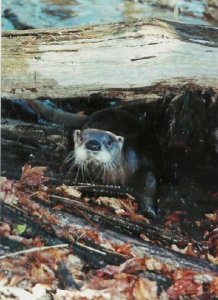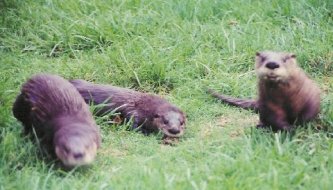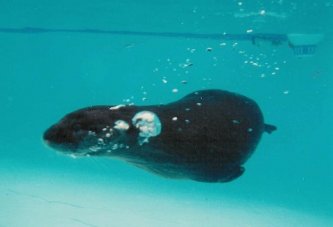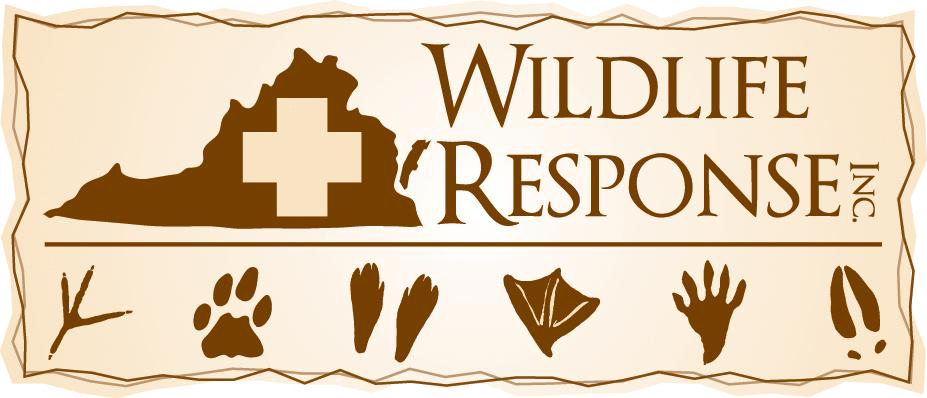(Lutra Canadensis)
 The North American river otter is the most numerous of the otter species. Otters are found throughout nearly all of Canada, Alaska and the continental United States with the exception of arctic regions and a small portion of the southwest United States. As polluted waterways have become cleaner, otters have returned.
The North American river otter is the most numerous of the otter species. Otters are found throughout nearly all of Canada, Alaska and the continental United States with the exception of arctic regions and a small portion of the southwest United States. As polluted waterways have become cleaner, otters have returned.
Otters are considered a semi-aquatic mammal. They are mostly seen in or near the water but are quite capable of overland travel, if the spirit moves them.
They are members of the weasel family, the “Mustelidas”. The first recognizable aquatic otter fossil dates to 30 million years ago. A species known as “Pakalutra jaegeri” lived in Europe 25 million years ago and may be the ancestor to the modern river otter. My rehabilitation work with the river otter has led me to describe them as trying to control the energizer bunny with the intelligence of a two year old, the strength of an ox, the teeth of a piranha and the temperament of a killer bee. Working with them is both challenging and rewarding.
The typical adult weighs between 11 and 22 pounds, and can measure 3 to 4 feet in length. They stand 10” at the shoulder. They have long, supple bodies that are extremely muscular. They are able to twist, turn, roll and dive effortlessly through the water. The eyes have a clear, third eyelid, nictating membrane, which covers the eye when swimming.
The otter’s feet are strong, well-webbed, and clawed. Otters can reach speeds of 7 mph under water and can dive to depths of 35 feet or more. They are capable of holding their breath 3 to 8 minutes. On land, they are capable of running up to 18 mph. The ears are small and lie flat against the head. The tail is furred and is long and rudder-like.
The fur is velvety in feel and thick. The color ranges from nearly black to reddish or grayish brown. Belly fur is lighter, usually silvery or grayish brown. The throat and cheeks are silvery to yellowish gray but are not clearly distinguished. The nose is diamond shaped.
 The long whiskers are used to detect prey in the substrate. Prey is eaten immediately after capture. River otters are extremely agile and highly intelligent. They are one of the few animals that seem to spend much of their time playing. They delight in making a game of everything. They will chase after a pebble or shell or each other for hours. They make a game of sliding down a slope and belly flopping in the water.
The long whiskers are used to detect prey in the substrate. Prey is eaten immediately after capture. River otters are extremely agile and highly intelligent. They are one of the few animals that seem to spend much of their time playing. They delight in making a game of everything. They will chase after a pebble or shell or each other for hours. They make a game of sliding down a slope and belly flopping in the water.
Otters often share territory with beavers. They are found in a variety of freshwater habitats, including streams, rivers, lakes, marshes and ponds. Otter dens are often dug into banks, but they will also use an old beaver lodge, muskrat den, or hollow log. They are most active at night. Otters will feed on fish, snakes, turtles, frogs, crayfish and almost anything they can catch. Research shows that otters feed on slow-moving fish such as suckers and catfish. They tend to eat the “trash” fish that compete with the more economically beneficial fish. Mating takes place shortly after the birth of pups, but otters have delayed implantation, allowing actual gestation to begin months later. Females give birth to 2-4 pups in early spring. They are born blind and toothless. The pups are helpless the first two months of life and remain in the den. Otter pups are weaned between 3 and 4 months. When the otter pups are weaned, father sometimes joins the female to help raise the pups. Mother begins swimming lessons after the pups are 2 months old. The average life span of river otters in the wild is 10-20 years. Captive otters have reached an age of 23.
River otters are usually found alone or in pairs, but will sometimes socialize in larger groups. “Play” activities are used to strengthen social bonds, practice hunting techniques, and to scent mark. They have boundless energy and an extremely high metabolism which requires them to eat a great deal. Their home ranges are large and they may be up to 20 square miles. Individual males may travel 25 miles in a week patrolling the borders of their range and scent marking.
 River otters communicate through a wide range of activities and sounds. They vocalize with whistles, growls, grunts, chuckles, chirps and screams.
River otters communicate through a wide range of activities and sounds. They vocalize with whistles, growls, grunts, chuckles, chirps and screams.
They scent mark by urinating/defecating within their home range. The scent glands, located at the base of the tail produce a strong, musky odor.
River otters have no real predators. Other predators find them difficult to catch, due in part to their agility in the water. Otters are fierce fighters, but will occasionally fall prey to coyotes. Today, all otter species are considered threatened. Water pollution and excessive fur trapping are their biggest threats.
River otters pose little threat to humans or structures.

